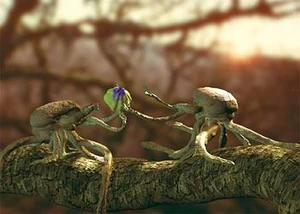
A baby squibbon passes food (a small lichen fruit) to its sibling. With their stereoscopic eyes, big brains and prehensile tentacles, squibbons are the acrobats of the Northern Forest.
The squibbon is an arboreal, highly intelligent, octopus-like terasquid from the Northern Forest in The Future is Wild. It spends all its life high in the canopy, far more flexibly-adapted in the treetops than any vertebrate.
In the trees above a lumbering megasquid, a party of squibbons will swing about, keeping wary eyes on the bigger animal below. Squibbons are the most agile of the terasquids, having adapted their natural dexterity to a tree-dwelling existence. They swing through the branches, not brachiating (swinging one arm after the other), as gibbons used to, but looping end-over-end in a continuous somersaulting action. Their eyes are set on muscular stalks, which stay with the body's center of gravity as they swing through the trees, always looking forward towards the next branch. With their sharp vision and large brains, they are able to navigate through the forest at speed.
Squibbons feed mostly on plants, but are agile enough to snatch forest flish from the air, grabbing their prey with a pair of dexterous tentacles. Each tentacle is equipped with highly-developed suckers, or suction cups, forming fingerlike protuberances which are so flexible that a squibbon can manipulate small objects and even use simple tools. For young squibbons, chasing other animals (like forest flish) can sharpen their senses and coordination.
Squibbons live in communes, building simple, nest-like structures in the uppermost branches of the forest. They are highly sociable animals, working together to defend their territory from any megasquid that blunders into it. Should one of these giants seize a baby squibbon in its suckered tentacles, it can expect to be mobbed and harassed until the prey is released, sometimes away snatched to safety by an adult squibbon. Branches are used as clubs, and fruits and spore polyps as missiles to fend off the huge predator. Indeed, weapons and warfare seem to be evolving again in 200 million AD.
Squibbon society displays an intelligence closer

A squibbon surveys its territory with strange, stalked eyes. 200 million AD, squibbons are at the pinnacle of evolutionary intelligence. But what does the future hold?
to that of humans than anything that has evolved since the Quaternary period of the Cenozoic era. While the ability to operate tools and act communally reflects an intelligence ideally suited to life in the Northern Forest, it may be that a changing environment will encourage the development of even greater sophistication. Perhaps a reasoning type of intelligence will evolve once again.
200 million AD, squibbons represent the pinnacle of intelligent life on Earth. However, intelligence is just one measure of evolutionary success. Other species, perfectly adapted to their habitats, may be waiting to take their place at the top of the food chain. Even so, the Northern Forest could still be the birthplace of a new civilization.
Trivia
- The squibbon's agility and obscure origins may have been partly inspired from both the long-armed ziddah and the striger from After Man: A Zoology of the Future.
- The name is a portmanteau of "squid" and "gibbon".
|
|||||||||
